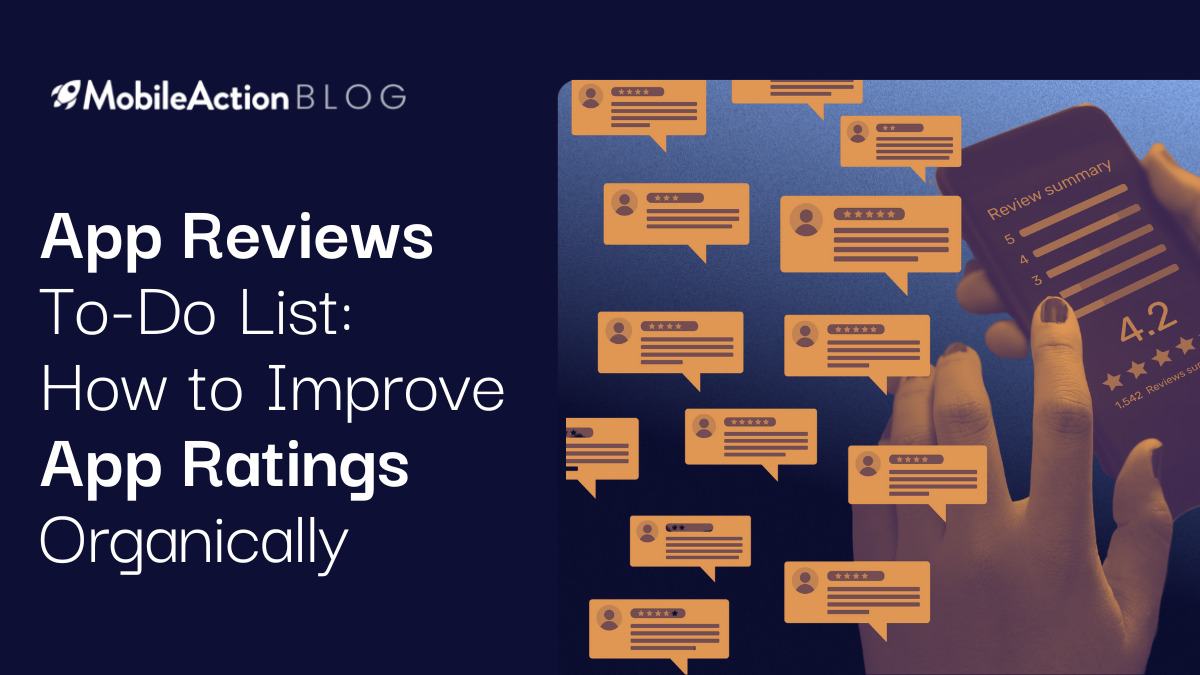User ratings and reviews have become the cornerstone of success. Positive reviews not only serve as social proof but also influence potential users’ decisions. Conversely, negative feedback can prevent potential downloads and hinder your app’s growth.
While paid strategies can boost ratings and reviews, they often lack the authenticity that organic feedback provides. Organic growth, driven by genuine user experiences, not only demonstrates the quality and value of your app but also ensures long-term sustainability.
In this comprehensive to-do list, we’ll explore effective strategies to organically improve your app’s ratings and reviews. From encouraging users to share their thoughts to updating the app regularly, we’ll cover the eight key pillars of organic growth. We are also going to cover some of the value that MobileAction adds to your implementation of ratings and reviews.
If you’re eager to learn and enhance your app’s reputation, attract a larger user base, and cultivate a community of satisfied customers, all through genuine ratings and reviews, then let’s embark on this journey together by reading this blog. If you’re short on time, our experts are ready to discuss how MobileAction can assist you!
1) Ask Users to Share Ratings/Reviews
Positive user ratings and reviews can significantly boost your app’s credibility and visibility in the competitive app market. However, users often need a little nudge to leave feedback. Here’s how to encourage them to share their thoughts:
In-App Prompts: Consider implementing well-timed in-app prompts that kindly ask users to rate or review your app. Ensure that these prompts appear at appropriate moments when users are likely to have positive sentiments about your app. For instance, after a successful transaction, when they achieve a milestone, or upon completing a tutorial.
Offer Incentives: Consider offering small incentives, such as in-app currency, exclusive content, or premium features, to users who take the time to leave a review. However, ensure that these incentives comply with the guidelines of the app stores to avoid any violations.
Personalize Requests: Tailor your review requests to each user’s experience. For instance, if a user has been consistently engaged with your app, you might say, “We noticed you’ve been enjoying our app. Would you like to share your thoughts?”
By implementing these strategies, you can increase the likelihood of users leaving positive ratings and reviews, which can have a substantial impact on your app’s reputation and download numbers.
2) Simplify the Review Process
The key to receiving more user reviews lies in simplifying the process as much as possible. A complex or time-consuming review process can discourage users from sharing their feedback. Here’s how to streamline it:
Reduce Friction: Minimize the number of steps required to leave a review. Ideally, users should be able to do it with just a few taps. Avoid asking for too much information, such as lengthy surveys or personal details.
One-Click Reviews: Consider implementing one-click or one-tap review options. These make it incredibly easy for users to leave a rating without much effort.
Simplifying collecting reviews is a good thing to have, but easily analyzing the entire review breakdown is a must-have for an app owner. For those who want to view ratings and reviews on a single dashboard, MobileAction developed the App Intelligence.
Deep Links: Use deep links that take users directly to the review section of the app store. This eliminates the need for users to navigate through the store to leave a review, saving them time and effort.
Prepopulate Feedback: If possible, prepopulate the review form with a star rating and a short message thanking the user for their feedback. Users can then edit and personalize their reviews as they see fit.
Offer a Preview: Provide users with a preview of what their review will look like. This can encourage them to complete the process, knowing exactly how their feedback will be presented.
By making the review process quick and hassle-free, you’ll remove barriers that might deter users from sharing their thoughts about your app. This, in turn, can lead to a higher volume of valuable reviews.
3) Choose the Right Moment for Review Requests
Timing is crucial when it comes to requesting reviews from your users. To maximize the chances of receiving positive feedback, you need to choose the right moments. Here’s how:
Timing Matters: Be mindful of when you ask for reviews. Avoid bombarding users with prompts shortly after they download the app. Instead, wait until they’ve had a chance to explore and engage with it.
Positive User Experience: Select moments when users are likely to be in a positive frame of mind. For example, after they’ve achieved a significant milestone in your app, successfully completed a task, or received a reward.
Avoid Interruption: Ensure that review requests don’t interrupt the user experience. Don’t prompt users when they’re in the middle of a critical task or during an in-app purchase process.
Regular but Not Excessive: Implement a well-timed and balanced approach to review requests. Too many prompts can irritate users, while too few can miss opportunities for feedback. Strike a balance by spacing out requests intelligently.
Monitor User Behavior: Use analytics to track user behavior within your app. Identify moments of high engagement and satisfaction, and trigger review requests accordingly.
By requesting reviews at the right moments, you increase the likelihood that users will provide positive feedback, helping to improve your app’s overall rating.
The best way to monitor user behavior is to listen to them actively. App Intelligence by MobileAction helps you display the most recent reviews of your apps on a single dashboard. In this way, you can easily understand their pain points and make the necessary updates.
4) Respond to User Reviews
User engagement doesn’t end once you’ve received reviews. In fact, it’s just the beginning. Responding to user reviews, both positive and negative, is an essential part of maintaining a positive image for your app. Here’s why it matters and how to do it effectively:
Show Appreciation: Express gratitude to users who leave positive reviews. A simple “Thank you for your kind words” goes a long way in making users feel valued and appreciated.
Address Concerns: For negative reviews, take the time to address user concerns and issues promptly. Apologize for any inconveniences they may have experienced and assure them that you’re working to improve the app.
Be Professional: Maintain a professional tone in all your responses. Avoid becoming defensive or argumentative, even if the review is critical. Your goal is to resolve issues and maintain a positive brand image.
Use Feedback Constructively: Use the feedback from reviews as valuable insights for app improvements. If multiple users mention similar issues, prioritize addressing those in your updates.
Using feedback as a tool to construct a robust app is a must, and App Intelligence by MobileAction eases this process. With its Most Mentioned Keywords Analysis feature, App Intelligence lets you understand your users’ main complaints and pain points on a map. In this way, you can see what the most frequently mentioned keywords are in negative comments and improve your app by focusing on these particular issues.
Engage in Dialogue: Encourage a dialogue with users who have left feedback. Sometimes, a constructive conversation can turn a dissatisfied user into a loyal advocate.
By actively engaging with user reviews, you not only demonstrate your commitment to improving your app but also build trust and loyalty among your user base.
5) Give Priority to Users with Unpleasant Experiences
Negative reviews and low ratings are opportunities for improvement. Instead of ignoring or dismissing them, consider these strategies:
Listen Actively: Pay close attention to negative reviews and take them as constructive feedback. Understand the issues users are facing and empathize with their frustrations.
Wendy’s is a fast food restaurant that listens to customers very actively. However, the way they tackle negative comments is so unique. They respond to people in a little bit of an arrogant but very smart and humorous way.
Prioritize Fixes: Address critical issues mentioned in negative reviews promptly. Users will appreciate seeing their concerns resolved in subsequent updates.
Reach Out: In some cases, reach out to users who left negative reviews to offer personalized assistance or to inform them about recent improvements. Turning a dissatisfied user into a happy one can lead to a positive review update.
Educate and Guide: If negative reviews are due to user misunderstandings or difficulties, consider creating in-app tutorials or help sections to guide users effectively.
By actively addressing negative reviews, you demonstrate your commitment to improving the user experience, which can lead to more positive feedback in the long run.
6) Release Updates Regularly
Frequent updates are a powerful way to keep users engaged and satisfied. Here’s why they matter and how to do them effectively:
Fix Bugs and Issues: Regular updates should include bug fixes and performance enhancements to ensure a smooth user experience.
Introduce New Features: Innovate and add new features to keep your app fresh and exciting. Address user requests and suggestions when possible.
Enhance the UI: Continuously refine the app’s design to make it more intuitive and user-friendly.
Communicate Changes: Clearly communicate what’s new in each update through release notes. Show users that you’re actively working to improve the app.
By keeping your app up-to-date and improving it regularly, you not only retain existing users but also attract new ones who are looking for an app that evolves with their needs.
7) Utilize Multiple Communication Channels
Effective communication can make a significant difference in how users perceive your app:
Social Media: Use social media platforms to share updates, tips, and user stories. Engage with your audience and encourage them to share their experiences.
As an example, consider KFC, the company known for its renowned “secret” chicken recipe featuring 11 herbs and spices. Surprisingly, their Twitter account only follows the 4 Spice Girls and 7 men named Herb. While it remains uncertain for how long the @KFC account has been following this unique group of Herbs and Spice Girls, it’s clear that they’ve certainly mastered the art of Twitter engagement.
Email Marketing: Maintain an email list of users and send out newsletters with valuable content, updates, and special offers.
In-App Messages: Use in-app messages sparingly to inform users about new features, promotions, or important announcements.
Feedback Surveys: Conduct occasional surveys to gather user feedback on specific aspects of your app, helping you identify areas for improvement.
A multi-channel communication strategy ensures that you reach users where they are most comfortable, increasing the chances of their continued engagement and positive feedback.
8) Focus on Improving the App
Ultimately, the key to better ratings and reviews is an exceptional app. Here’s how to maintain a user-centric approach:
Usability Testing: Continuously test your app with real users to identify pain points and areas for improvement.
Competitor Analysis: Stay informed about what your competitors are doing well and where they fall short. Use this knowledge to outperform them.
User-Centered Design: Design your app with the user’s journey in mind. Make sure it’s intuitive, easy to navigate, and visually appealing.
Feedback Loops: Establish feedback loops with users through surveys, customer support, and social media to gather insights for future enhancements.
By making ongoing efforts to create an exceptional user experience, you’ll naturally generate more positive ratings and reviews.
Key Takeaways
- User reviews are crucial for app success, influencing potential users.
- Organic growth via genuine user experiences is more sustainable and authentic.
- Strategies to improve app ratings organically include:
- Encouraging users to share ratings and reviews.
- Streamlining the review process to make it user-friendly.
- Timing review requests to positive user experiences.
- Responding to both positive and negative reviews professionally.
- Prioritizing and addressing negative reviews for improvement.
- Regularly updating the app and communicating changes.
- Utilizing multiple communication channels to engage users.
- A user-centric approach focused on usability, innovation, and feedback loops leads to better ratings and reviews.
- App Intelligence by MobileAction can get you a snapshot of app stores listing information you need about any app.




